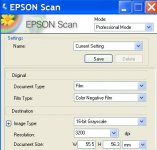chatanooga
Member
I use a Nikon 9000 and scan in grey-scale. I have to assume Nikon assign the optimum channel for the scan (eg green). Creating an RGb representation of a BW negative seems a big waste of disk-space and scanning time. . If each channel's data is the same then you only need one of them; if they're different then you have some kind of uncontrolled color-cast. I would rather do any color conversion (eg PS 'photo-filter') when I've scaled the image down to print-size and retain the 'grey' image for archive.


